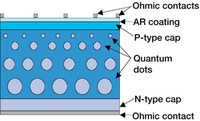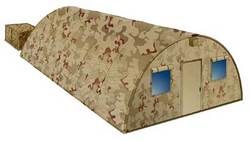In my online novel The Duke of Oil, I’m taking some liberties with the science of quantum dots. (Illustration from NASA.)
It’s true that Professor Michael Wong and his team at Rice have made an important breakthrough in the production of quantum dots, but it’s not true that we’re about to see a flood of cheap, highly efficient solar panels, powered by dots, on the market any time soon.
One reason for this is that quantum dots, like Buckytubes (called carbon nanotubes by non-Rice people) are useful in many other applications, besides solar panels.
In fact, solar panels are a sort of low-end use, dependent on mass production of a particular type of dot, made of cadmium selenide. In his research at Rice, Wong made two breakthroughs in the recipe for these dots.
First, he used a cheaper, safer catalyst, cetyltrimethylammonium bromide (it’s sometimes used in high-grade shampoos), rather than the caustic alkylphosphonic acids (used in flame retardants) previously used. Second, 90% of the dots created by his method were tetrapods, with four molecular "legs" reaching into the solution. These happen to be the most efficient types of dots for use in solar panels.
While some quantum dots have photovoltaic properties, most scientific work with them over the last decade has been in medicine, where they can be used as chemical sensors in medical tests.
The company which wants to be best known in this area, Quantum Dot Corp. of Hayward, Calif., is working entirely in the medical area, and was acquired in 2005 by Invitrogen, a medical products company. (Invitrogen, in Frederick Maryland, owns the old QDOTS.Com domain, but now points it to an Invitrogen address indicating the company’s specialty of chemical probes.)
Evident Technologies of
Troy, New York bills itself as the leader in quantum dot product
development, but is mainly selling them for use by other companies in
research. Its page advertising applications
is pretty, and gives a good account for the many varieties of dots and
potential applications, but the key word in this sentence is potential.
(The picture above, from Konarka Corp., is of a proposed camouflage shelter for the military which would recharge itself using quantum dots embedded in the fabric.)
Photovoltaic quantum dots, which are the kind Dr. Wong is working with, are exciting because they have the potential to convert 95% of the solar energy coming into them into electricity, three times the theoretical limit of silicon-based solar
cells, which are made just like computer chips. They can also be tuned
to deliver either high voltage or high amperage, something that’s
difficult with conventional silicon cells. And they can be placed
behind a protective shell, so that they last longer in the field.
Still, it’s one thing to find great things in a lab. It’s quite another to turn something into a production product. Evident has a venture with Konarka, which makes a photovoltaic plastic sheet called "power plastic" that can recharge a laptop, which will use its "EviDots."
The problem is that the money for working with quantum dots today is
primarily coming from medical companies and the military, not from the
energy industry. It’s telling that Konarka co-founder Howard Berke (right)
recently left the company
to join a green energy fund. He couldn’t draw the big bucks to
Konarka’s "power plastic," even with the Evident link-up, leaving the company in
the hands of former MA/COM President Rick Hess.
Maybe the two can now do a deal together. Maybe Hess is the
"grown-up" Wall Street will trust with money for quantum dot energy.
But maybe don’t get ‘ur done. What this field needs is some mad money, and lots of it.














November 21, 2009.
Dr. Michael Wong is now also a director of Hague Corp., owner of Solterra Renewable Technologies. They are on the verge of mass producing CdSe quantum dots to order. With billionth of an inch coating needed, only a few grams are needed per panel.
They have exclusive rights from Rice for quantum dots.
They have exclusive rights from U of Arizona for a ink printing press adapted to flexible PV solar panel production. Mass Production is promised to begin by Q1 next year and one printer production line could reach from the 100s of megawatts to soon a gigawatt from one.
They are working with Access2Flow to develop a mass production of quantum dots, starting with the goal of a kilogram a day, to an order of magnitude from there.
CEO Stephen Squires has concluded that CdSe quantum dots are the only way there is a chance to accomplish the 20% by 2020 goals. He may be willing to sell the dots and franchise production and mounting.
November 21, 2009.
Dr. Michael Wong is now also a director of Hague Corp., owner of Solterra Renewable Technologies. They are on the verge of mass producing CdSe quantum dots to order. With billionth of an inch coating needed, only a few grams are needed per panel.
They have exclusive rights from Rice for quantum dots.
They have exclusive rights from U of Arizona for a ink printing press adapted to flexible PV solar panel production. Mass Production is promised to begin by Q1 next year and one printer production line could reach from the 100s of megawatts to soon a gigawatt from one.
They are working with Access2Flow to develop a mass production of quantum dots, starting with the goal of a kilogram a day, to an order of magnitude from there.
CEO Stephen Squires has concluded that CdSe quantum dots are the only way there is a chance to accomplish the 20% by 2020 goals. He may be willing to sell the dots and franchise production and mounting.
That's a great update. I really enjoyed reading what Dr. Wong has been up to. I thought his work with quantum dots was very interesting, but Rice has often been less than successful in finding commercial applications for their research.
Dana
That's a great update. I really enjoyed reading what Dr. Wong has been up to. I thought his work with quantum dots was very interesting, but Rice has often been less than successful in finding commercial applications for their research.
Dana